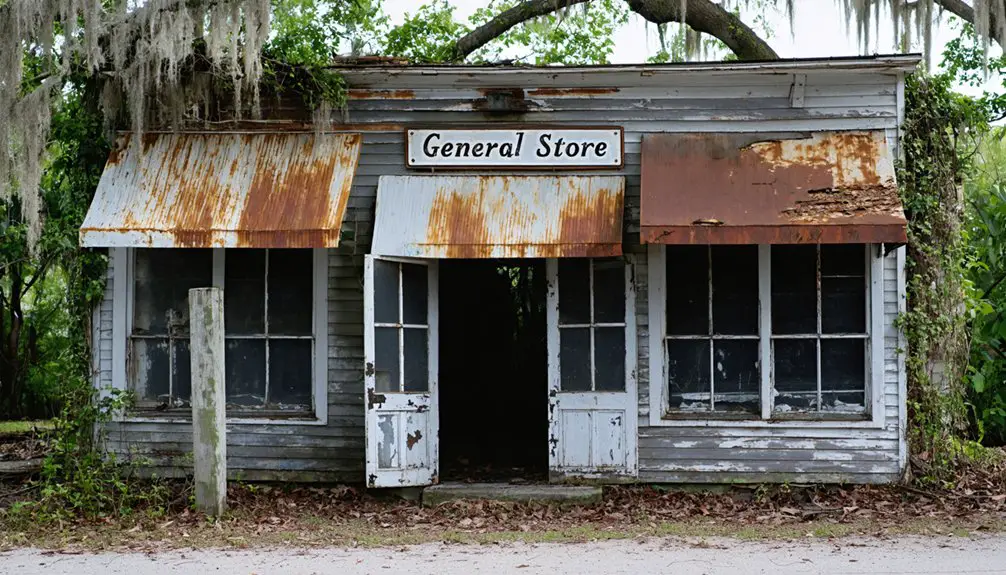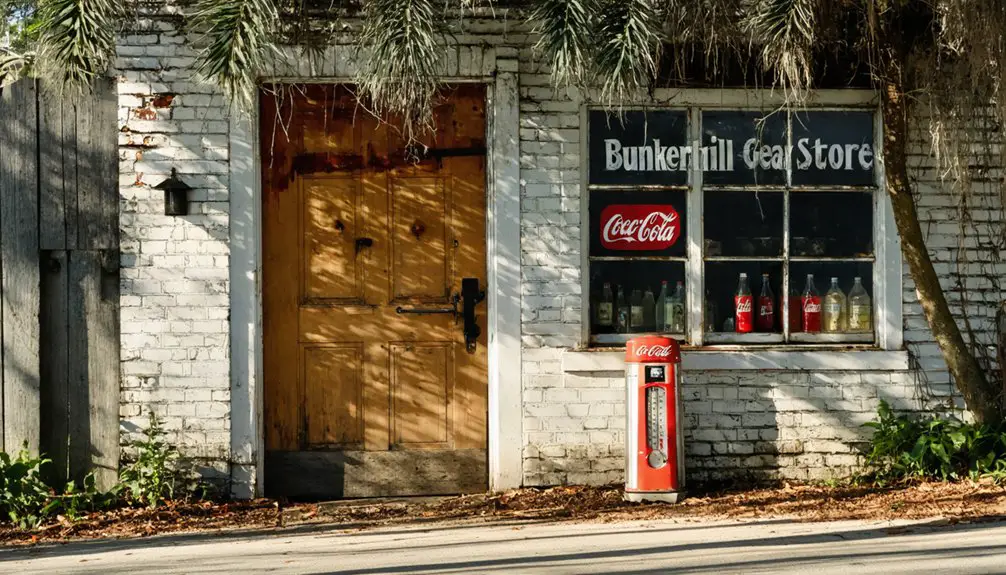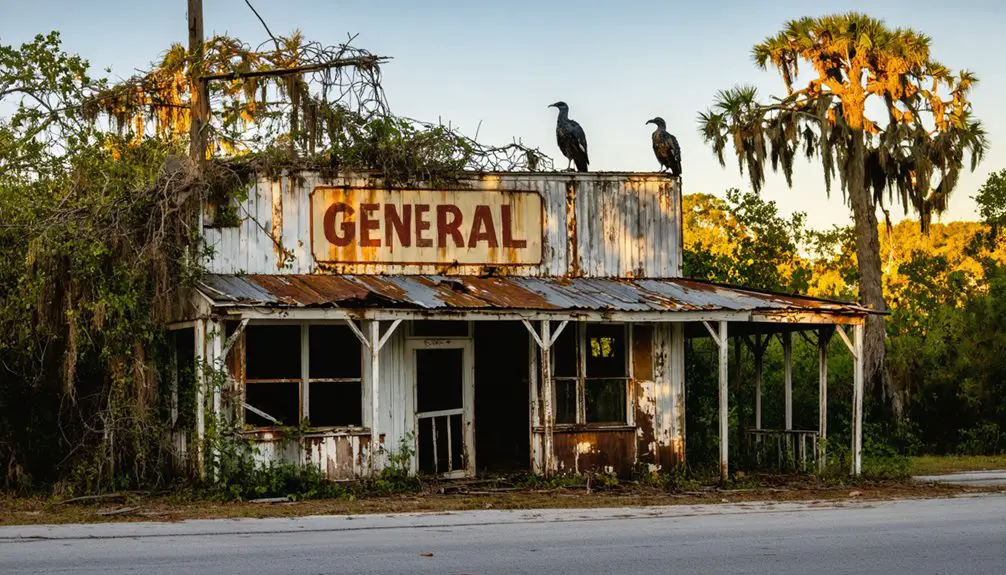You’ll discover Bunkerhill’s transformation from a thriving 1800s rural settlement in Hernando County to a modern ghost town. The community flourished with farms, orange groves, and essential infrastructure including schools, churches, and steamboat wharves. By 1926, the construction of U.S. Route 70 diverted traffic, leading to population decline and eventual abandonment. Today, Bunker Hill Vineyard and Winery draws visitors seeking paranormal encounters amid the settlement’s historic remnants.
Key Takeaways
- Bunkerhill was established in Florida during the 1800s as a rural settlement with farms, orange groves, and essential infrastructure.
- The town declined due to economic shifts, agricultural mechanization, and the construction of U.S. Route 70 diverting traffic in 1926.
- Only scattered farms and road signs remain of the original settlement, which merged with nearby communities to maintain essential services.
- Bunkerhill Vineyard and Winery now operates as a paranormal tourism destination featuring documented ghost sightings and spirit walks.
- Historical preservation efforts continue through photographic archives, heritage documentation, and community engagement in protecting historical sites.
The Birth of a Rural Community
As settlers ventured into Hernando County during the 1800s, the area that would become Bunkerhill emerged as a sparsely populated rural settlement.
You’d find early homesteaders establishing farms and orange groves, creating a network of local trade among neighboring families. Community growth accelerated when the area began attracting workers for nearby facilities and resource extraction projects. Like the Black Hills Ordinance Depot, the area provided essential wartime resources.
The transformation from scattered homesteads to an organized community brought rapid development. The area’s mysterious history includes reports of paranormal activity throughout the surrounding land. Agricultural practices remained central to the area’s sustainability, with families maintaining small farms for self-sufficiency.
As the workforce expanded, essential infrastructure sprouted up, including housing, a hospital, and a school. The influx of laborers and their families created a diverse social fabric, bound together by shared employment and the demands of rural life.
Educational Legacy and School Consolidation
When Bunker Hill School opened its doors in 1908, it exemplified the era’s typical one-room schoolhouse education, serving students from ages 6 to 21 in northeast Manatee County, Florida.
You’d find a single teacher instructing classes of 10 to 25 students from 8 AM to 4:30 PM, with sessions initially running August through December. Students carried their daily meals in enameled lunch pails to sustain them through the long school days.
The educational transformation came in 1930 when Bunker Hill consolidated with Albritton and Duette schools, creating a larger five-room facility built through community engagement and volunteer labor.
Local community spirit drove Bunker Hill’s 1930 merger, transforming a one-room schoolhouse into a five-room educational hub through volunteer efforts.
This merger reflected broader regional trends toward efficiency and expanded educational access. Similar to many districts in Illinois during the 1940s, one-room schools dominated the educational landscape before consolidation efforts began.
The consolidation strategy continued when Bunker Hill later joined with Clay Township to form Maconaquah High School, offering students a more extensive curriculum and increased educational opportunities through shared resources.
Paranormal Encounters at Bunker Hill Vineyard
The peaceful grounds of Bunker Hill Vineyard harbor more than just educational history – they’ve become a focal point for paranormal enthusiasts and investigators.
You’ll find documented ghostly encounters ranging from moving objects to disembodied voices, with two professional paranormal groups confirming it’s among their most active sites.
Most significantly, spectral evidence points to the presence of Gerald, an elderly spirit whose identity matches historical records of a former landowner’s father. His ashes were scattered near the creek, where visitors often report supernatural activity.
The vineyard now hosts Spirit and Orb Walks, where you can bring EMF meters and EVP recorders to conduct your own investigation. The next scheduled walk on October 29th requires advance reservations and costs $10 per person.
Through temperature readings, audio recordings, and photographic documentation, you’ll discover why this location draws serious paranormal researchers year after year.
Located in Parrish, Florida, the winery combines traditional wine-making with its reputation as a haunted destination.
Historic Infrastructure and Buildings
Built upon steep terrain, Bunker Hill‘s historic infrastructure exemplifies early 20th-century engineering ingenuity through its network of tunnels and transportation systems.
The architectural significance of the area shines through its Victorian homes, constructed from the late 1860s, and the impressive military storage bunkers with their three-foot-thick concrete walls.
Similar to how wooden bridges lasted over 100 years when covered to protect them from the elements, these structures have endured through careful preservation.
You’ll find remarkable examples of historic preservation in the 3rd Street Tunnel, constructed in 1901, which operated alongside the original Angel’s Flight railway.
The area’s military development in the 1940s brought substantial changes, adding 802 storage bunkers and accommodations for 1,000 residents.
These facilities formed a self-sustaining community, complete with hospitals and recreational venues.
While much of the original residential area was later transformed into commercial districts, the remaining structures stand as evidence of the area’s engineering achievements.
The addition of the 2nd Street Tunnel in 1924 helped alleviate growing traffic congestion through the neighborhood.
The Tale of the Covered Bridge
Standing as one of America’s most remarkable engineering feats, Bunker Hill’s covered bridge showcases General Herman Haupt’s innovative “Improved Lattice Truss” design from 1839.
Built in 1895 by Andrew Loretz Ramsour, it’s possibly the last remaining wooden bridge in America using Haupt’s revolutionary system, which employs vertical supports pinned to diagonal timbers with wooden trunnels instead of nails.
You’ll find this covered bridge design particularly fascinating for its oak timber construction and unique structural elements that differ from conventional covered bridges of the era.
Originally spanning 91 feet across Lyle Creek, the bridge served local traffic until 1926. The bridge remains one of two covered bridges left standing in North Carolina.
While it’s now closed to vehicles, its historical significance earned it recognition as a National Historic Civil Engineering Landmark and a place on the National Register of Historic Places. Local residents initially built an open span, but in 1900 was covered to protect the wooden structure from weathering.
Life in Early Settlement Days
During the early settlement of Bunkerhill, Florida, Scottish and European immigrants from southern states established a vibrant community centered around plantations and farms.
The settler lifestyle revolved around agriculture, cattle herding, and trade, with families like the Campbells and McMullens shaping the region’s community dynamics through their entrepreneurial ventures and social connections.
- You’d find post offices and general stores serving as essential communication hubs where settlers gathered to exchange news and goods.
- Local infrastructure included wharves for steamboat landings, enabling transport of cattle and crops to markets like Tampa.
- Protestant Episcopal churches provided spiritual guidance, with traveling clergymen serving dispersed congregations.
- Education remained a priority, with landowners donating property for schools and academies despite frontier conditions.
The Path to Becoming a Ghost Town

While the early settlement days of Bunkerhill showcased a flourishing rural community, the town’s path toward abandonment began through a series of interconnected factors in the early 20th century.
You’ll find that population decline accelerated as economic shifts transformed the agricultural landscape, with mechanization reducing the need for small-scale farming communities.
The construction of U.S. Route 70 in 1926 diverted traffic from local roads, further isolating the settlement. As younger generations sought urban opportunities, Bunkerhill consolidated with Keenville, Duette, and Dry Prairie to maintain basic services like education.
Shifting transit patterns and urban migration forced Bunkerhill to merge with nearby towns, preserving only essential community services.
Today, you won’t find any buildings or structures remaining in Bunkerhill – only road signs mark where this once-vibrant farming community stood, while scattered farms continue operating in the surrounding area.
Supernatural Tourism and Modern Appeal
Despite its abandoned status, Bunkerhill has found new life as a paranormal tourism destination centered around the Bunker Hill Vineyard and Winery.
You’ll encounter a sophisticated ghostly tourism experience where supernatural experiences await, backed by documented evidence of paranormal activity including moving objects, unexplained voices, and mysterious orbs captured on camera.
- Spirit and Orb Walks let you investigate with professional ghost-hunting equipment like EVP and EMF meters.
- Wildlife cameras have documented inexplicable phenomena, including mysterious white photos and battery drains.
- Visitors have identified specific spirits, including an 80-year-old man named Gerald connected to the property’s history.
- The vineyard’s unique blend of wine culture and paranormal activity draws investigators from around the world.
Preservation of Local Heritage

As time has eroded most of Bunker Hill’s physical structures, dedicated preservation efforts now focus on protecting its remaining historical landmarks and cultural heritage.
You’ll find the Bunker Hill Covered Bridge, built in 1894, stands as the area’s most significant architectural artifact, having undergone essential updates including wooden shingles in 1900 and tin roofing in 1921.
Community involvement extends to protecting burial sites with strategic bamboo placement and documenting oral histories through the Bunker Hill Vineyard’s records.
Heritage awareness continues through Spirit and Orb Walks, which combine historical education with paranormal tourism.
While physical remnants are scarce, you’ll discover the legacy lives on through historical websites, ghost town registries, and photographic archives that maintain geographical and cultural connections to this fascinating piece of Florida’s past.
Frequently Asked Questions
What Was the Total Population of Bunker Hill During Its Peak?
You’ll find that 300 residents marked Bunker Hill’s peak population in 1930, before population decline set in. Despite ghost town myths, census records clearly document this zenith before the Dust Bowl’s impact.
Are There Any Remaining Original Structures Still Standing in Bunker Hill Today?
You won’t find any confirmed original structures still standing today. Historic preservation efforts weren’t established, and without architectural significance documentation, remaining buildings have succumbed to decay, flooding damage, and neglect.
What Caused the Final Residents to Leave Bunker Hill?
With a 100% agricultural dependency, you’ll find that economic decline drove the final exodus, as farming became unprofitable and residents sought better opportunities in larger towns with more diverse job markets.
When Was the Last Recorded Permanent Resident in Bunker Hill?
You won’t find any documented record of the last resident in historical archives. While ghost sightings have been reported in nearby abandoned towns, no specific final inhabitant information exists for this location.
What Industries or Businesses Supported the Local Economy Before Decline?
You’ll find the local economy was primarily driven by lumber industry operations including sawmills, alongside agricultural practices focused on crop production, livestock raising, and fruit harvesting before the area’s eventual decline.
References
- https://www.bunkerhillvineyard.com/our-ghost-story
- https://www.ghosttowns.com/states/fl/bunkerhill.html
- https://www.youtube.com/watch?v=kXGAKmjGMXg
- https://www.thedistractedwanderer.com/2014/10/the-1894-bunker-hill-covered-bridge.html
- https://www.trolleytours.com/boston/bunker-hill-monument
- https://www.youtube.com/watch?v=kZ6VlX8XaKU
- https://abandonedfl.com/locations/
- https://floridatrailblazer.com/tag/hernando-county/
- https://www.nicf.org/wp-content/uploads/2018/03/Class-of-1964-John-McElheny-Memorial-Scholarship-Fund.pdf
- https://madison-historical.siue.edu/encyclopedia/school-district-consolidation-in-madison-county/



